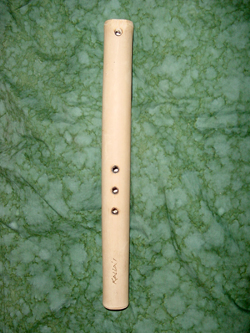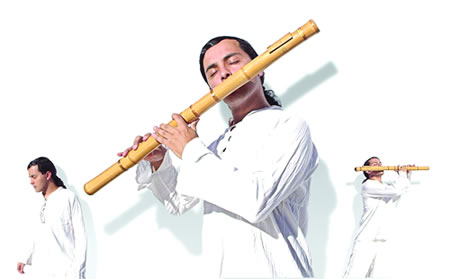
World Flutes Master

Take care of our enviroment

comprar

Peace web theme set courtesy of Crystal Cloud Graphics web set icon
Crystal Cloud Graphics
Crystal Cloud Graphics


Hoe Hano Ihu
The ‘ohe hano ihu, or nose flute, was among several instruments made from Hawaiian bamboo, which has thinner walls than foreign species. The flutes ranged from a foot to a little less than two feet long, with one end open and the other end closed. The majority had two finger holes to change the pitch, although some had one hole and others had three. The spacing of the holes varied from one artisan to the next, and there seems to have been no standard.
The nose flute is played by blowing air from the right nostril into a hole just above the closed end. The left thumb or index finger closes the left nostril, concentrating air through the right side. The right hand is used to hold the flute and to cover the finger holes to change notes.
Known as “he mea ho‘oipoipo” or “a thing for lovemaking”, the nose flute is said to have been used to communicate messages between lovers as well as to accompany hula. One researcher was told a story which suggested that a god taught the technique of making ‘ohe hano ihu to a prince so he could woo a princess from the valley below.
The nose flute is found throughout Polynesia, and the Bishop Museum has flutes from Hawai‘i, the Carolines, Fiji, the Marquesas, Tonga, Niue, Futuna, and Tahiti. Interestingly, the Samoan version of the nose flute was played using the mouth, and in New Zealand, lacking bamboo, the flutes were made of human bone or wood.
The ‘ohe hano ihu, or nose flute, was among several instruments made from Hawaiian bamboo, which has thinner walls than foreign species. The flutes ranged from a foot to a little less than two feet long, with one end open and the other end closed. The majority had two finger holes to change the pitch, although some had one hole and others had three. The spacing of the holes varied from one artisan to the next, and there seems to have been no standard.
The nose flute is played by blowing air from the right nostril into a hole just above the closed end. The left thumb or index finger closes the left nostril, concentrating air through the right side. The right hand is used to hold the flute and to cover the finger holes to change notes.
Known as “he mea ho‘oipoipo” or “a thing for lovemaking”, the nose flute is said to have been used to communicate messages between lovers as well as to accompany hula. One researcher was told a story which suggested that a god taught the technique of making ‘ohe hano ihu to a prince so he could woo a princess from the valley below.
The nose flute is found throughout Polynesia, and the Bishop Museum has flutes from Hawai‘i, the Carolines, Fiji, the Marquesas, Tonga, Niue, Futuna, and Tahiti. Interestingly, the Samoan version of the nose flute was played using the mouth, and in New Zealand, lacking bamboo, the flutes were made of human bone or wood.









